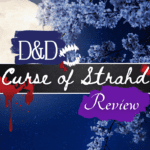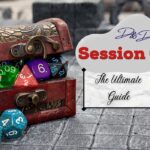We have 8 D&D storytelling tips to help you improve your game. If you are looking to improve your storytelling, you need to know what you are after.
There are 2 ways D&D storytelling tips can help you. Either you need to improve your story structure, or improve your delivery.
If you need to improve your structure then what you are planning/writing isn’t living up to what you want. If you want to improve your delivery this involves charisma and how you deliver the narrative to your players.
Identifying what you need
In order for any D&D storytelling tips to matter, you need to know what you need help with.
As stated before, there are 2 ways to improve. With story structure, and with devlivery.
The structure of a story can be referred to as the plot, but there are some differences. If you are looking for how to create a plot, you should read this article here, but there are some major differences. The plot is where you intend for your story to go by what NPCs are doing or what quests the party will be offered. Your storytelling is how well you weave the narrative together.
Think of it like this. The plot is a rough structure of your ideas while your storytelling structure is how you present those ideas to the players. You will have more information than them and will craft a plot, but the players don’t know everything. That is why if you have papers, notes, and an idea where things are going but still make a bland story for your players the structure of your storytelling needs to be improved.
Conversely, you might need to work on your minor areas of delivery. You might have the most amazing story in the world and have it crafted in a way that the players will be enthralled at the information presented, but if you are mumbling the story and looking away from them it won’t matter.
Most deliveries are not as bad as this, but there are some issues that may keep you from presenting your master-crafted story. If this area is not done well, then your lack of charisma will cause an issue in your storytelling.
After reading this you might have figured out what you need to work on. If you are very sure that 1 area is your main problem, then just go there but I would highly suggest reading everything. You might find out that you are missing something that you would not have known otherwise.
Making players care
The first of our D&D storytelling tips is going to be about making players care. This is a structural issue that many DMs have a problem with. You can create an amazing plot, story, NPCs, etc but if your players do not care then everything you have done is worthless.
The first way to make players care is to look at your NPCs.
Take a long hard look at your NPCs. Do your players like the idea of meeting a new NPC or do they instantly suspect them? Do your NPCs have a healthy mix of helpful and harmful NPCs or are they all bad?
Many DMs think that they provide a wide array of NPCs, but that is not the case. A lot of the time players will feel like any NPC introduced will betray the party if you are not very careful as a DM. It doesn’t even matter if you are right. Player perception is what matters, and if they think that every NPC is bad then your story can be predictable or even destroyed.
The second way to make players care is to make them important.
Your players should not be the center of the world from a plot standpoint. If the party didn’t exist or died the next day people would go on living, but you need to make the players feel like they are the center of the world.
As your players do things to help people make those actions meaningful. Have your players end up gaining allies, praise, and even notoriety from their actions. Most people like the feeling of being famous, so make them famous. Their influence depends on their level and accomplishments, but they should feel important.
We want to play games to feel important and live out a fantasy. You do not want your players feeling like this is just a daily grind or your story will lose its luster. Speaking of luster….
Ambiguous

The second of our D&D storytelling tips is to be a bit ambiguous. We have talked about how players will veer away from the path of sanity and do things that are completely unexpected. Your players might also end up dying or real life can happen, so if you focus the story too much on a player then the story might fall apart.
That is why you need to make people feel important, but make any future deeds unclear. If your party ends up being told that they will kill a god for example, they might decide to bargain with it and screw over the world. That is why instead of giving clear statements, give them ambiguous ideas like “you will tend to a great evil.”
That statement means nothing and can be interpreted in any way. Keep this sense of mystery going. You might think you have all the cards, but you can be a flustered as anyone at the players’ antics. Just keep up the illusion that everything is going according to plan even if you are internally screaming.
You do need to make sure that the players have the information they need though. Be ambiguous about certainties, but the players should always have the most information possible. If you just spring an ‘ah ha!’ moment on them to trick the players they might feel cheated or lose all sense of agency. This will kill your story, so keep your players informed. They will make more interesting decisions if they are informed.
All this leads to how to deal with plot holes.
Plot holes

“I need you to go kill this goblin. Yes, I am a level 17 fighter but oh man my boot! It needs to be repaired and I have a pie in the oven so you should go do it. Hurry or the town is doomed!”
Plot holes like these make no sense. If a god tasks your party with saving the world there has to be a reason why they can’t do it. That is why you need to keep up the ambiguity and add extra threads.
The best D&D storytelling tips on how to avoid plot holes are to start with little threads. Give your players a quest hook and have them deal with something. If they finish it great. If not, then they might have to deal with the consequences later. Learning how to use consequences is essential in making these plot threads, and can help you create a personal story that truly invests your players.
Having little threads here and there that are not solved or are offshoots of the adventure tell the players that there are more things going on than what they know. For bigger issues, you are able to link it to something else that the players experienced.
If players have experienced that the world is larger than them then they are more likely to buy it. If it is an obvious plot hole like the example above, then you can just drop it and chalk it up to human laziness or something instead of making a whole campaign based around a plot hole.
A great to get around plot holes is to listen to your players.
Listening to players
Yes, we are still in story structure. You are crafting a story, but you are doing so with the help of your players. If they feel invested they will make more interesting actions and make the story better overall. Any story told with your players is better than a story you would tell by yourself.
That is why if you listen to your players, you will be able to avoid plot holes, disinterest, and make your players more engaged overall. This is one of the most important D&D storytelling tips that you will learn.
Planning out an epic story might seem like a great idea, but you should have an idea of a start and an ending. Leave the middle blank so that you can add a few things here and there while the story becomes better with your players.
You will also find out that the story might be going too fast or too slow. People will get bored if the story is too slow and will be exasperated if the story is too fast. If you listen to your players and see how they are acting, you can figure out when to turn up or turn down the intensity of your story.
A general rule is to have some buildup to a climax where there is a lot of action and then a breather afterward to digest the action and get ready for the next round. It may be different with your group, but this is a good practice to follow.
Improving delivery
We are finally at the second part of how to improve your storytelling! Now that you have a good idea of how to make a story, you need to pay attention to how you deliver your story.
There are 4 ways that people’s delivery falls short:
- Bad body language.
- Filler words.
- Unable to find the words.
- Unable to describe a scene.
Every 1 of these D&D storytelling tips have a chance of destroying your player’s immersion. This is why you need to take a hard look at every way and figure out how to improve it.
There are amazing storytellers that will bring everyone into the tale. Listeners are leaned in, waiting on bated breath for every word, and that is what you want to be. So let’s get into these words and look at how we can improve our charisma!
Body language

“The DM looks at the table, speaking aloud but unable to make eye contact. Her hands are fidgeting and she is nervously shifting about. Her arms are also tucked in, and she is a little hunched over at the table.”
Compare that image to this.
“The DM looks at the part with intense focus as she speaks making eye contact for a few seconds with each person. She leans in a little bit and backs out when there is a pause raising her eyebrows to garner attention. Her shoulders are open and her arms/hands are gesturing giving life to the scene as she changes positions to suit the story.”
The second scenario is much better, but why exactly? Compare every part.
- Eye contact.
- Gestures.
- Intensity.
- Posture.
- Using her hands to enhance the story instead of giving off nervous vibes.
- Pauses that show confidence instead of fumbling.
There are more, but you get the idea. How we use our bodies will make or break a scene. If you use your body correctly you can enamor anyone and bring them into the story.
These are some ways to help you understand the basics of body language, but I highly recommend looking up how to be aware of and improve body language on your own. Doing so would take another article, and there are plenty of articles on the subject already. Just pay attention to your body language.
Filler words

“The dragon um, he ah, flies over you and um breaths a blast of fire at ahh Timmy.”
Compare that to this.
“The dragon flies over you and breaths a blast of fire at Timmy!”
All the second example did was take away the filler words, but it came out far better!
We often use filler words unless we are trained to speak, and filler words take away the feeling of confidence you get from a speaker. It makes the speaker sound like they don’t know what to say or don’t know what to do. That is why you need to stop using filler words.
If you have to, pay attention to words that do not add anything to your conversation. It will be jarring at first and you may have to record yourself, but it will eventually be painfully obvious.
Instead of using filler words just pause and do not say anything. Taking your time to think makes you look more composed even if you have no idea what to say. Pausing also brings people’s attention back to you while rambling on makes people tune you out.
Our D&D storytelling tips on filler words boil down to this, pause if you need to and don’t use filler words. Cut them out of your vocabulary, and you will be a more interesting speaker.
A great way to avoid filler words is to be able to find what words you want to speak about.
Finding the words
We use filler words because we are unable to find the proper words to describe an event or a scene. Pausing is 1 of the great D&D storytelling tips for your charisma, but you still need to be able to find the words.
If you are only using basic 4-6 letter words to tell a story it won’t be as interesting. That is why you need to find the words to tell a story.
To make a story more interesting, think of a word that you commonly use. It could be death, strike, kill, etc. Now, look up a synonym to that word. You can go to Thesaurus.com for help. Repeat this process for at least 10 words that you commonly use.
Try in your next two weeks to use these words. It will feel silly at first, but eventually, you will start to own these words. They will become natural and easier to recall. Repeat the process until you feel comfortable with a broad vocabulary.
If you know more words and have a bigger vocabulary you are less likely to use filler words. In addition, you will be able to describe the scene or interaction with vivid detail. This detail will draw people into your story.
Describing a scene
You have the proper body language, words, and are not using filler words. Now is the time to start practicing how to describe a scene.
The last of our D&D storytelling tips is to have practice describing a scene in your off time.
If you have a favorite monster practice describing what it would be like to encounter the creature. Consider all 5 senses (sight, smell, sound, touch, and taste) when describing the scene. Always incorporate at least 1 sense and try to incorporate 2-3 if possible. Describing the senses that people feel in a scene will help it come alive on a personal level.
You can go beyond this and practice describing how the monster lives it’s life. Describe the putrid stench the goblin gives off, the greasy unwashed skin that they have, go into detail but only tell the essentials to get the point across. You do not want to go into a paragraph about how the goblin stinks. Just give a sentence to convey the disgust that creature emits.
You don’t have to do this with just monsters. You can do this in your own personal life. After an event has just happened narrate it in your head with a paragraph. Get a journal and write about something that happened in your day.
If you can, look back on your work and see what you can improve upon.
These are all ways to help you practice setting up a scene.
Conclusion
There are 8 D&D storytelling tips that we have talked about. 4 are to help you improve your story structure while the other 4 are focused on improving your delivery.
Not everyone needs help with both aspects, but both parts of storytelling are important in making a worthwhile story.
I hope that these tips helped you improve your storytelling skills.
This has been Wizo, and keep rolling!
Find us on Twitch:
https://www.twitch.tv/levelupcorner
Find us on YouTube:
https://www.youtube.com/channel/UCWNkoo0iRoysNdlkWZdfnrQ
Want to support our creators? Find our Patreon here:




